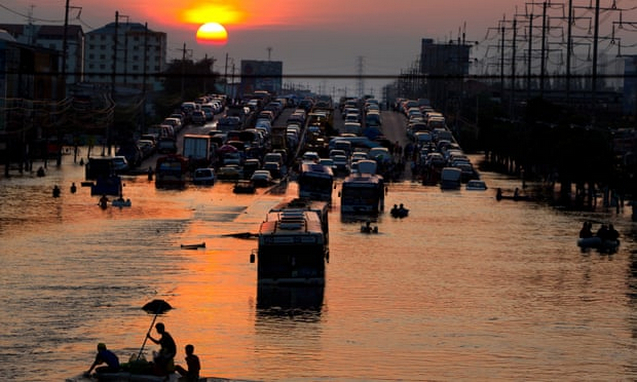Threat to major population centres is increasing as planners fail to prepare for impacts of global warming, report says
landmark new report on climate science.
The threat to cities from sea level rises is increasing because city planners are failing to prepare, the charity Christian Aid said in the report. Some big cities are already subsiding – the ground beneath Shanghai, for instance, is being pressed down by the sheer weight of the buildings above – and rising sea levels resulting from global warming will make the effects worse.
The cities named in the report are sinking for a variety of reasons. Jakarta is thought to be subsiding by 25cm a year largely because of groundwater extraction, and Houston is sinking as the oil wells beneath it are depleted. Bangkok’s skyscrapers are weighing it down, while London is slowly sinking for geological reasons: Scotland is slowly rebounding after having been weighed down by glaciers during the last ice age, which is pushing southern England downwards like a see-saw.
The warning comes as the world’s leading climate scientists meet this week in South Korea to finalise a comprehensive study setting out whether and how the world can avoid temperature rises of 1.5C above pre-industrial levels. The Intergovernmental Panel on Climate Change (IPCC), the body of scientists convened by the UN, has been asked to examine the consequences of such a rise and assess what progress can be made to limit greenhouse gas emissions.
The world has already warmed by roughly 1C from pre-industrial levels, and sea levels could rise by 40cm if that increases to 1.5C, previous science from the IPCC has suggested. Sharp brakes on greenhouse gas production are expected to be needed to halt the rise.
Christian Aid, one of many organisations publishing studies to coincide with the IPCC’s judgment, looked at the consequences of a 1.5C rise for a selection of eight major cities around the world. The report concludes that poor development choices are exacerbating cities’ vulnerability to weather shocks.
Kat Kramer of Christian Aid, who wrote the report, said: “These global metropolises may look strong and stable, but it is a mirage. As sea levels rise, they are increasingly under threat and under water.”
Dozens of the world’s biggest cities are built in coastal areas and near major rivers, making them vulnerable not just to sea level rises but also to storm surges, which can send high seas inland and past maritime defences. The UK and the Netherlands experienced such a storm in 1953, when high tides and a storm surge inundated coastal regions. If similar weather were to strike today, the damage could be much greater despite sea defences, because of rising sea levels and the increased severity of storms that is likely to result from climate change.
Links
- Which Cities Will Sink Into The Sea First? Maybe Not The Ones You Expect
- The three-degree world: the cities that will be drowned by global warming
- Intergovernmental Panel on Climate Change (IPCC): Global Warming of 1.5 °C
- As Bangkok sinks, could this anti-flood park be the answer?
- From Miami to Shanghai: 3C of warming will leave world cities below sea level
- Lincolnshire's coast and farms will sink with 3C of warming
- The three-degree world: the cities that will be drowned by global warming
- Sea level rise will double coastal flood risk worldwide
- Europe faces droughts, floods and storms as climate change accelerates
- Statue of Liberty and Venice among sites at risk from climate change, says UN
- US east coast cities face frequent flooding due to climate change
- Floods could 'overwhelm Thames Barrier by end of century'


No comments :
Post a Comment